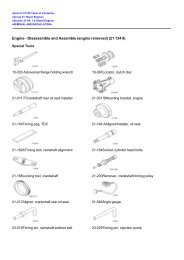TECHNICAL NOTES ON THE EEC-IV MCU - Auto diagnostics
TECHNICAL NOTES ON THE EEC-IV MCU - Auto diagnostics
TECHNICAL NOTES ON THE EEC-IV MCU - Auto diagnostics
Create successful ePaper yourself
Turn your PDF publications into a flip-book with our unique Google optimized e-Paper software.
Eectch98-Part5.fm<br />
16d (Table 1). Also, fill in the lower rpm VE tables (Table 3) with 30, and try to<br />
start the engine without grinding the starter too much. The engine will warm up<br />
enough to wake up the O2 sensor, look at the scanner, and see where the BL is, and<br />
IAC Counts. The IAC Counts are a vacuum leak. So they are critical to a decent<br />
idle.<br />
Now you have some idea of where the mixture is, and what the kPa is from reading the<br />
scan tool. From experience you can’t run the same numbers everywhere at idle. On the<br />
high side of idle kPa go richer, i.e.; with an engine that idles at 60 kPa if it is<br />
30 there, at 65-70 it would be 32, and at 50-55 28. Yes, the 30 is a lot but its<br />
easy to go lean, and clean up the idle, then having stall all the time, and having<br />
to wait for the prime shot to burn out.<br />
Next, lean the VE values (Table 3) down till the O2 is swinging (value moving back<br />
and forth through .45 volts), the IAC is less than 10, and you have a min idle<br />
speed. For the initial butterfly opening I cut a strip of paper 1/4" wide and set<br />
the throttle idle setting so the paper is pulls through the butterfly opening with a<br />
minimum of effort and without tearing. Now the engine starts and will idle. This<br />
is a good start.<br />
Light Cruise<br />
This section is on how to do light throttle cruising set ups, using GM ECMs. This<br />
is for an engine using a slightly hotter than stock cam, healthy ignition and assuming<br />
that some roughing out of the fuel timing tables have already been done.<br />
The objectives are: Advance timing as much as possible consistent with minimum<br />
throttle opening; and use just enough fuel to run 128 or slightly lower BL numbers.<br />
For monitoring the engine, a digital volt meter (DVM) is attached to the Throttle<br />
Position Sensor (TPS), a vacuum gauge is hooked up to the manifold (but this is<br />
almost redundant of the TPS), a scan tool is hooked up for looking at the Block<br />
Learn (BL) numbers, and a 10 element LED display is attached to the oxygen sensor.<br />
With this wired up it is easy to now start changing the timing of the 40 kPa areas<br />
of the fuel map by rpm for cruise. On a flat road with the car in top gear, find<br />
the cruise speed at 40 kPa and note the DVM signal from the TPS. Add timing and<br />
repeat the road test at the same TPS value. Observe whether the vacuum value is<br />
above or below the original signal. Repeating this procedure will reach a limit<br />
where the knock sensor will start retarding timing. Next, drop off as much timing<br />
going to the 20 side (overrun), which richens the O2 readings and helps to cut the<br />
fuel on overrun, so the car slows when you take your foot off the gas. On some of<br />
the OEMs you almost have to hit the brakes to slow the car.<br />
From the 40-50 kPa vacuum value, again depending on your car, drop off as little<br />
timing going toward 100 kPa (full throttle), as possible. Run enough fuel in the VE<br />
table so that when pulling slight grades the motor doesn’t chug (love that technical<br />
language). Also use a minimum amount of timing for the WOT spark value.<br />
A suggestion is stay on the low side of the BL 128 at cruise so the engine is<br />
instantly smooth and pulling when the gas is nudged. There is no difference in MPG<br />
between this and 128. If you have the capability for pulse width modulation (PWM)<br />
of the EGR I’d turn this off during the initial tinkering so that you don’t chase<br />
too many items at one time. Just doing the spark and fuel can be an exercise in<br />
patience. Also, with a big cam just off idle and just as you go to light cruise at<br />
say 30-35 mph, you may have a dodo area (in this area of the PROM maps, BLs are<br />
lousy regardless of timing AFR). What is happening is the engine is starting to<br />
wake up, the intake tract length is starting to work, and the engine is reducing its<br />
self EGR. Pulling from 1600 rpm in high gear, smoothly from a roll might be the best<br />
performance test possible. Some engines just don’t like to lug down to 1400.<br />
<strong>EEC</strong>-<strong>IV</strong> Technical Notes: Modifications/Upgrades63 last edited: 9/29/98




